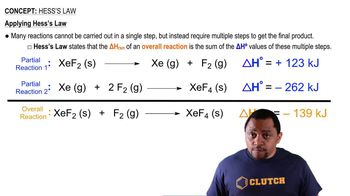Here are the essential concepts you must grasp in order to answer the question correctly.
Enthalpy of Formation
The standard enthalpy of formation (ΔH°f) is the change in enthalpy when one mole of a compound is formed from its elements in their standard states. It is a crucial value used in thermodynamics to calculate the heat changes in chemical reactions. Each substance has a specific ΔH°f value, which can be found in tables, and is essential for determining the overall enthalpy change of a reaction.
Recommended video:
Hess's Law
Hess's Law states that the total enthalpy change for a reaction is the same, regardless of the number of steps taken to achieve that reaction. This principle allows chemists to calculate the enthalpy change of a reaction by summing the enthalpy changes of individual steps, making it possible to use standard enthalpies of formation to find ΔH°rxn for complex reactions.
Recommended video:
Reaction Stoichiometry
Reaction stoichiometry involves the quantitative relationships between reactants and products in a chemical reaction. It is essential for balancing chemical equations and determining the amounts of substances consumed and produced. In the context of calculating ΔH°rxn, stoichiometry helps in applying the correct coefficients from the balanced equation to the standard enthalpy values to ensure accurate calculations.
Recommended video:
 Verified step by step guidance
Verified step by step guidance


